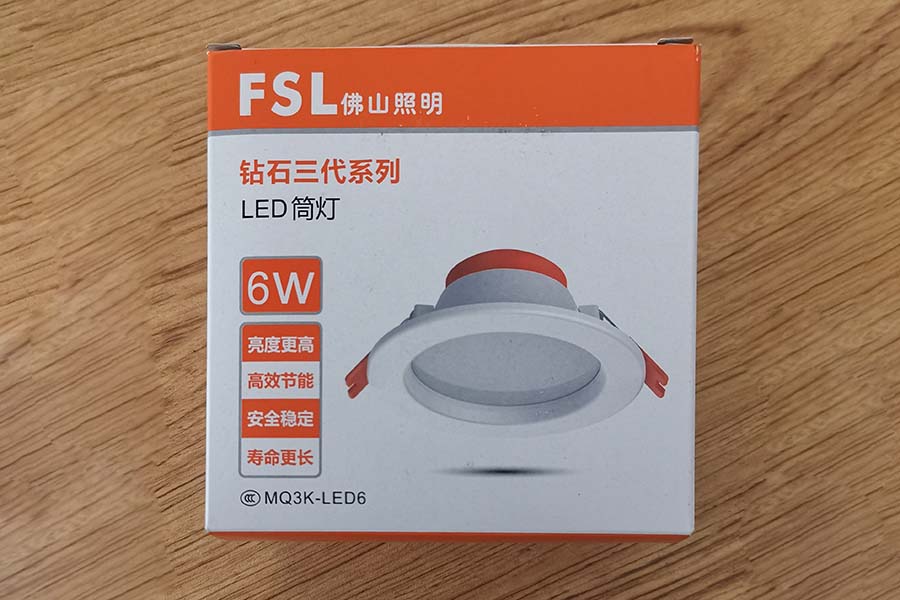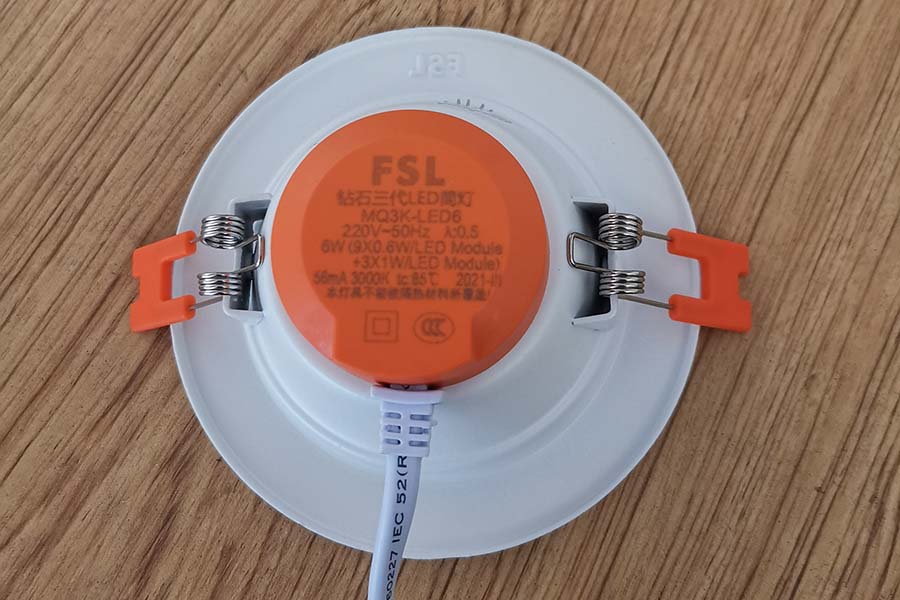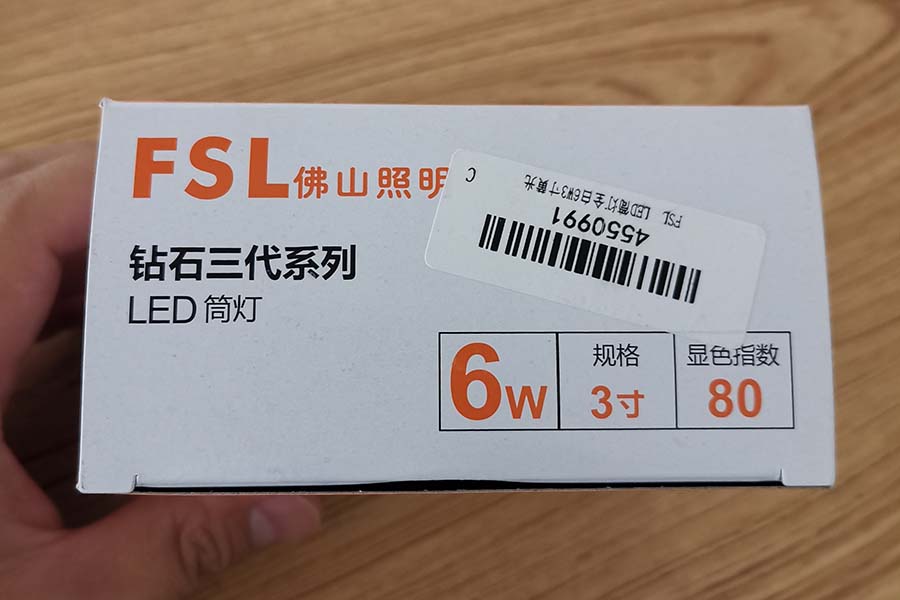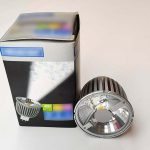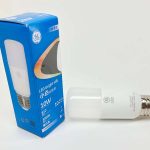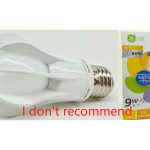Recessed LED downlights are embedded into the ceiling to become a seamless accessory in your room.
Many house owners like this sleek look.
However, you may not know the factors that contribute to the quality of LED downlights.
There are many reputable brands in the market.
Sometimes it can be difficult and even confusing to make a buying decision for many users.
BackMorning is a third-party quality inspection company.
Focus on the LED lighting industry only from the beginning.
We have intensive experience with LED lights, even those of some leading brands.
For this reason, we decided to buy a sample of FSL LED downlight MQ3K-LED6.
Use it as an example to explain how to choose a good LED downlight.
After reading this review post, you will understand the basic parameters for a good LED downlight.
Below is some basic information about this sample.
- Model: FSL, MQ3K-LED6
- Specifications: 6.0W, 3,000K, 220V
1. Take Quality as a Priority to Consider
Usually, LED downlights are installed on the ceiling.
Usually, it’d be best the lights will last for years after installation.
And you won’t need to bother with maintenance or replacement.
For this reason, we’d say quality should be the first thing to consider when you buy LED downlights.
Especially, it’s common to install multiple LED downlights on the ceiling, rather than only one.
So, it’d be better to minimize the risk of issues due to lower quality.
2. First Impression on Overall Design
The body of the FSL LED downlight sample is made of aluminum.
And it has a heat sink made of aluminum as well.
This design may not be worth mentioning regarding the appearance.
But it has significant meaning for the lifespan of LED lights.
Heat dissipation is critical for the lifespan of many electronic materials.
Generally speaking, the hotter an electronic component is, the shorter its life span becomes.
For this reason, it’s always important for an LED light to have good heat dissipation.
Aluminum is a good thermal conductor.
It is widely used in different industries, particularly useful for building heat sinks.
This FSL downlight has a heat sink made of aluminum.
We can say it has a good foundation for assuring life span.
Meanwhile, one more thing to mention about the first impression.
The body of this FSL downlight is a kind of matte white.
Not glossy white.
This is a commonly good choice to match various interior designs.
Bonus tip:
- Besides, there are different colors available for the bodies of LED downlights.
- Common alternative designs include black, and silver (polished aluminum).
- You can pick the one that matches your interior design.
After the first impression, then we come to the most important parts.
They are the electrical performance and the spectrum test.
In plain English, we are going to talk about how well this downlight illuminates your space.
We use professional instruments to test FSL LJTD3-L50-12S1P-6W.
And we obtain some important parameters.
Both the instruments and test methods are common practices for some other household names.
3. Voltage range
We would like to talk a little bit about the working voltage range.
It’s essential to make sure the light will work properly within a voltage range.
The power grid doesn’t provide electricity at a fixed value – like exactly 220V all the time.
Actually, it supplies electricity within a voltage range.
It’s important to make sure the light will work normally within a given range of voltage.
That means the LED light won’t flick when the input voltage rises or drops within its rated range.
And we also must avoid the lights, which go off completely when the voltage changes.
As for the FSL LED downlight sample, it doesn’t flick within its applicable voltage.
And it stays on constantly.
This result means it is good within its rated voltage range.
4. Spectrum Test
In this part, we are going to talk about the quality of its light.
Below is the data that we’ve got after testing it with a spectroradiometer.
And we will talk about the values one by one.
1). Total Lumen
Lumen is a measure of the total quantity of visible light emitted by a source per unit of time.
In plain English, it indicates how much horsepower a car produces with burning the same volume of gas.
Therefore, if you want a brighter light, then pick the one with a bigger Lumen value.
- This FSL LED downlight doesn’t indicate its Lumen value on its package.
- Its tested value is 383.2 Lumen
Generally speaking, this value is comparatively a little bit low among similar downlights.
However, the retail price is also approximately 30% lower than other top brands.
You can decide whether it’s your pick.
2). LM/W
The lumen to watt ratio indicates the efficiency of the LED light.
It indicates how much light is output per Watt of energy consumed.
It’s the same concept as how much horsepower a car produces with 1 liter of gas.
A bigger value of LM/W indicates the LED light produces more light.
That means this light is more energy-efficient.
- FSL indicates a rate value of 70 for its LM/W.
- While the tested value that we got is 64.9.
We can’t say it’s great.
But technically it’s within the acceptable tolerance -/+10%.
You can make your own decision by comparing its sales price and LM/W.
If you are more concerned about costs, then this light is a good pick.
But if you are more concerned about performance, then this light is not the best pick.
3). RA
This parameter measures the color rendering property of an LED light.
It is called General Color Rendering Index.
It measures the ability of a light source to reveal colors of objects in contrast to a natural light source.
Quite often, the same object looks different in different lighting conditions.
The object itself has not changed, but its appearance changes.
The object itself doesn’t produce light.
It reflects the light from a source to your eyes.
For this reason, the value of the color rendering index is important for you.
Generally speaking, a bigger value of the color rendering index means better quality of the LED light.
- FSL’ sample indicates this value 80 on its package box.
- The tested value is 82.5.
This result is already quite good for regular applications for homes and offices.
4). SDCM
SDCM is an acronym that stands for Standard Deviation Color Matching.
The lower the number of SDCM, the smaller the color shift.
Suppose that you install multiple downlights on the ceiling.
If their SDCM value is too big, you will see one color for the first light.
And another color for the second light.
Will you be happy to see such a lighting effect?
- The downlight MQ3K-LED6 has an SDCM value of 2.0.
- This is a great result.
This light can be a good choice if you only install one light.
Or if you install multiple of them together.
5). CCT
For regular users, you can think about Correlated Color Temperature or CCT in a simplified way.
Take it as a gauge of how yellow or blue the color of light emitted from an LED light appears.
It’s measured in the Kelvin unit.
And common CCT values are between 2,200 – 6,500 Kelvin degrees.
The CCT value 2,889 is a good choice for a wide variety of applications.
They include outdoor site lighting, general retail, offices, hospitals, etc.
LED lights with the CCT numbers from 2,700-3,500K appear to be warmer.
The feeling is like the sun in the morning and the dawn.
This light is a good choice if such a feeling is what you prefer.
6). Wattage
- The sample has a rated wattage of 6W.
- While the test value is 5.9W.
This is a great result for this downlight sample.
5. Conclusion
Generally speaking, this FSL LED downlight offers good value for money.
And it’s a good choice regarding the quality of light – color rendering, color temperature, and color uniformity.
Meanwhile, it’d have been better if its efficiency for producing light was higher.
You can consider it if the sales price is your priority.
Last but not least, it’s always more than happy to do more reviews on other LED lights.
That’d be helpful for people to make good buying decisions.
- What do you think about our review on this FSL LED downlight sample?
- And which LED light you wish to know in our next review post?
Please leave us a comment.
And we will be happy to test and review it.
Thanks for reading!

